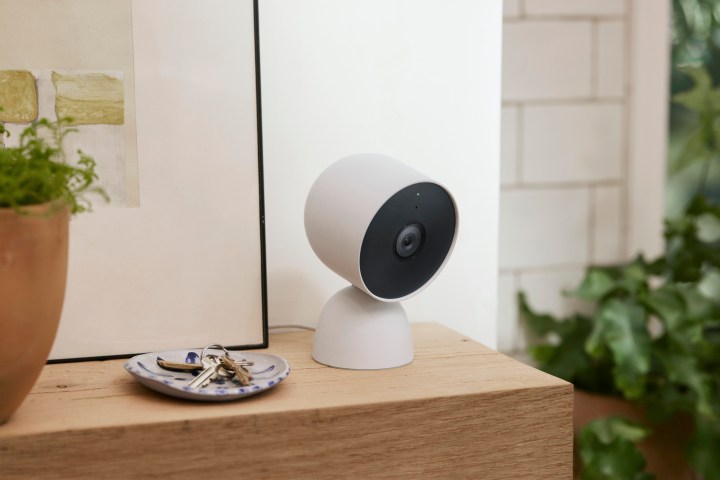Smart home connectivity isn’t just about entertainment. Web-connected homes the world over use smart tech to manage energy costs, control lighting, adjust the temperature, and achieve total peace of mind through intuitive home security systems. Now more than ever, smart security products dominate the marketplace, with major brands selling everything from cameras and floodlights to motion sensors.
Google, an alpha in the big tech landscape, is one such home security provider. Through the company’s multiple generations of Nest devices, Google Home devotees have been able to monitor and customize an assortment of security gear. Speaking of Nest gear, there are a few new kids in town to meet.
Google’s latest revamp of its Nest lineup brings us the Google Nest Cam (battery), the Google Nest Cam (wired), and the Google Nest Cam with Floodlight. If you’re thinking it’s time to buckle down your property with a home security device, one of these cameras may do just the trick. To help you decide which is best, we’ve pitted all three models against each other, weighing in on things like design, features, and price.
Design
The Nest Cam (battery and wired models) build upon the structural framework of its predecessor, the Google Nest Cam IQ. Where the Nest Cam IQ features a skinny spinal column that links the base to the actual camera body, the new Nest Cam parts ways with the thin neck in favor of a short base-to-camera-housing connector. It also appears that the lens housing and base feature a more rounded design.

Both new Nest Cam iterations measure 3.27 inches tall and 3.27 inches in diameter and weigh 14.04 ounces. Ditching the chrome shell of its elder, the Nest Cam (battery) comes in a glossy white casing referred to as Snow. The Nest Cam (wired) is available in the Snow color as well as three other (yet unspecified) casings.
Details on the more robust-looking Nest Cam with Floodlight are still scarce, but initial images show an elongated neck column with a rounded lens housing. Two LED floodlights, about the same size as the camera, are attached to the spine. As of right now, official dimensions and color options are unavailable.

Features
Both the Nest Cams (battery and wired) are equipped with a 2-megapixel sensor that delivers 1080p HD at 30 frames per second in full HDR. In terms of what this means visually, we can expect stellar imagery with well-balanced contrast and eye-catching color, both for day and nighttime viewing. The lens itself delivers a 130-degree diagonal field of view and 6x digital zoom, which is a big must-have for the familiar face recognition (more on that below).
The Nest Cam (battery) comes with an optional 3.65-volt rechargeable lithium-ion pack, making it easy to mount and connect your camera to Wi-Fi without the need for direct hardwiring. Factors like video quality, activity zones, and length of recorded clips will affect battery life. In setups where an average of 13 to 16 motion events are recorded per day, you can expect your Cam battery to last for about 2.5 months before it needs a recharge.

Video from both Nest Cams will be available 24/7 through the Google Home app, along with customization options for creating motion-trigger activity zones, as well as adjustments for people, animals, package delivery, and vehicles. Both cameras also come with three hours of cloud storage for recorded video.
With a $6/month Nest Aware subscription, you’ll get extra features like an additional 30 days of cloud storage, familiar face detection, and the ability to phone 911 directly from the Google Home app. For $12/month, a Nest Aware Plus plan will net you 60 days of cloud storage, along with 10 hours of continuous video recording with wired Nest Cams.
While we’ve yet to receive any official performance specs and features about the Nest Cam with Floodlight, we’ll be sure to report back once we hear more.
Price
The Google Nest Cam (battery) sells for $180 and is available for pre-order now, officially hitting shelves on August 24. The Nest Cam (wired) will go for $100, and the Nest Cam with Floodlight can be purchased for $280. These latter models do not have an official release date yet, but we’ll report back once we learn more.
The verdict
In terms of overall value and performance, the Nest Cam (battery) seems to offer the most bang for your buck. With all the customization options available through the Google Home app, you can truly outfit the camera to be an adept personal watchdog that only alerts you when necessary, and the magnetic base makes for an easy install to the exterior of your home.
If you’re shopping on a budget, the Nest Cam (wired) offers a similar suite of features, minus the rechargeable battery, so you’ll be limited to what power outlets are available in the area you want to place the camera.
While we’ve yet to gain serious intel on the Nest Cam with Floodlight, we imagine the camera will feature some of Google’s most impressive video specs, thanks in part to the built-in lighting rig.


